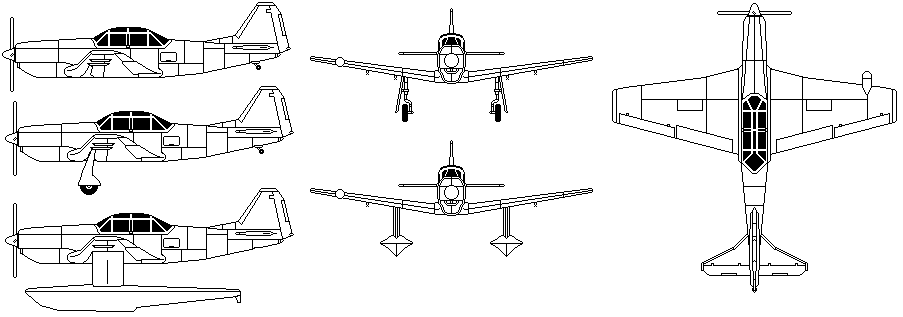

In April of 80PA officers among the Tamiya Elite indicated a need for a purpose built observation/utility aircraft capable of patrolling the growing territory of New Haven, transportation of VIPs, and delivery of sensitive dispatches vital to communications in the furthest corners of New Haven. This lead to Tamiya Nyan charging the new Republican Industries with the design and construction of a versatile aircraft of conventional design that could serve in a multitude of roles including observation, recon, light attack, anti-submarine warfare, and as a basic trainer for the planned New Haven Air Force. Optimally the aircraft would be electric or nuclear powered and be capable of operating from rough strips or as a float plane with minimal conversion time.
Thanks to Drake Murphy, a former aeronautics engineer employed by Golden Age Weaponsmiths, the new design went from the drawing board to limited run production in only two years time. While the tail assembly needed to be redesigned after a structural failure during a test flight, the final version was ready to begin production by the winter of 82PA. This new aircraft was a conventional low-wing monoplane with no integral weapon systems, but with two hard points under each wing, coupled with a fire control computer. Also worked into the design was for the inboard hard points to be configured to adapt to detachable floats for take-offs and landings on relatively calm waters. While the maximum speed did not need to approach purpose built combat aircraft, such as Sky Cycles, its conventional design permitted it to operate at altitudes that exceeded that of most light combat aircraft used throughout North America.
In terms of avionics, the type employed a Magnetic Anomaly Detector under the right wing and a radome housing a short range radar on the right leading edge of the wing, complete with look-down capabilities, and a Target ID Computer. Propulsion was provided by a small reactor that powered its electrical motor driving a four bladed propeller, giving it exceptional loiter time for observation, recon, light attack and anti-submarine warfare duty. Later, when introduced as a trainer, the type proved to be a durable aircraft and a joy to fly. Thus the type was introduced to service as the Republican Industries Type 82 Sakura Utility Aircraft that very same year, and remains in service today.
Given the aircraft's success the Type 82 Sakura has become commercially available on the market throughout the "New West" and in some areas of the Central Powers region. The N.O.M.A.D. Air Force uses twenty-two aircraft of this type as basic trainers, several private courier companies have procured the type, and during the Tolkeenite War the Tolkeenite Air Corps procured 42 aircraft of the type, outfitted with a twin gun dorsal turret and cowling mounted TK Light Machine-Guns, designated the Type 82/7 Sakura for use in reconnaissance, light attack and as a gunnery trainer. None are believed to have survived the war.
